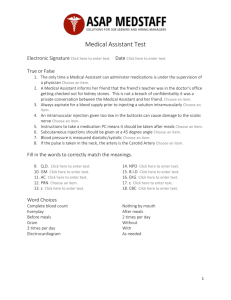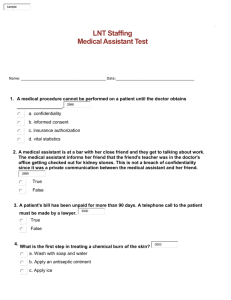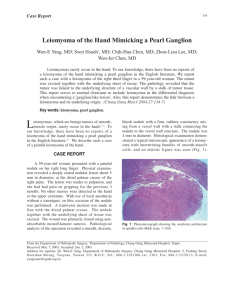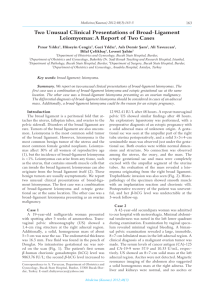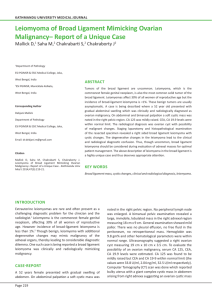URETHRAL LEIOMYOMA – A VERY RARE ENTITY
advertisement
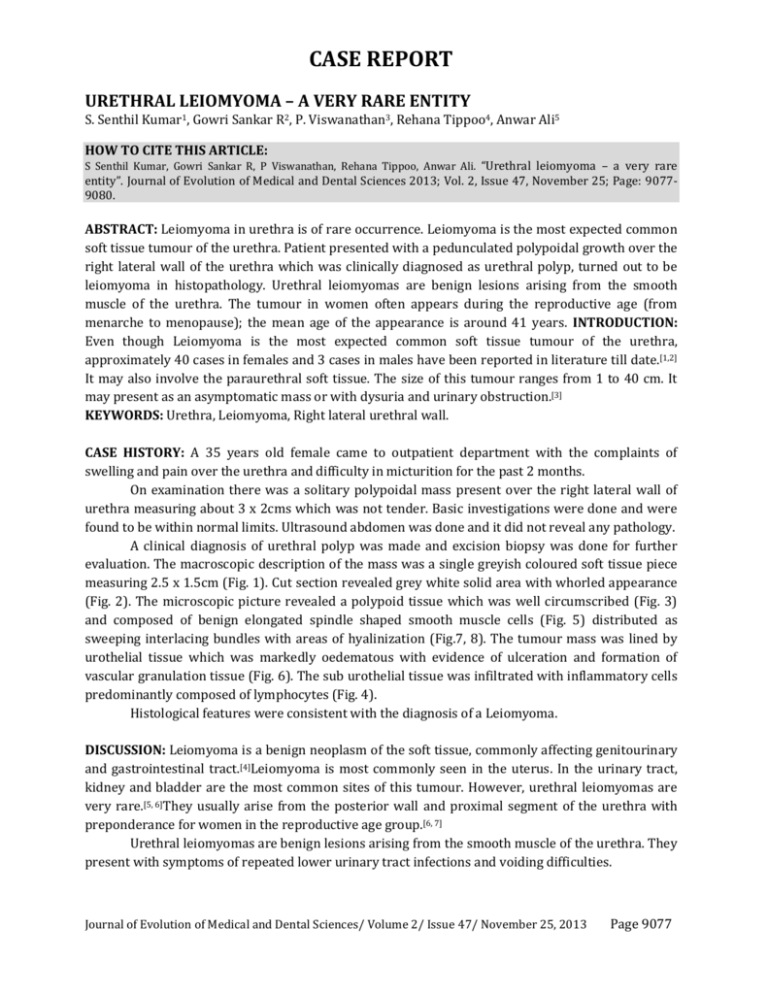
CASE REPORT URETHRAL LEIOMYOMA – A VERY RARE ENTITY S. Senthil Kumar1, Gowri Sankar R2, P. Viswanathan3, Rehana Tippoo4, Anwar Ali5 HOW TO CITE THIS ARTICLE: S Senthil Kumar, Gowri Sankar R, P Viswanathan, Rehana Tippoo, Anwar Ali. “Urethral leiomyoma – a very rare entity”. Journal of Evolution of Medical and Dental Sciences 2013; Vol. 2, Issue 47, November 25; Page: 90779080. ABSTRACT: Leiomyoma in urethra is of rare occurrence. Leiomyoma is the most expected common soft tissue tumour of the urethra. Patient presented with a pedunculated polypoidal growth over the right lateral wall of the urethra which was clinically diagnosed as urethral polyp, turned out to be leiomyoma in histopathology. Urethral leiomyomas are benign lesions arising from the smooth muscle of the urethra. The tumour in women often appears during the reproductive age (from menarche to menopause); the mean age of the appearance is around 41 years. INTRODUCTION: Even though Leiomyoma is the most expected common soft tissue tumour of the urethra, approximately 40 cases in females and 3 cases in males have been reported in literature till date. [1,2] It may also involve the paraurethral soft tissue. The size of this tumour ranges from 1 to 40 cm. It may present as an asymptomatic mass or with dysuria and urinary obstruction.[3] KEYWORDS: Urethra, Leiomyoma, Right lateral urethral wall. CASE HISTORY: A 35 years old female came to outpatient department with the complaints of swelling and pain over the urethra and difficulty in micturition for the past 2 months. On examination there was a solitary polypoidal mass present over the right lateral wall of urethra measuring about 3 x 2cms which was not tender. Basic investigations were done and were found to be within normal limits. Ultrasound abdomen was done and it did not reveal any pathology. A clinical diagnosis of urethral polyp was made and excision biopsy was done for further evaluation. The macroscopic description of the mass was a single greyish coloured soft tissue piece measuring 2.5 x 1.5cm (Fig. 1). Cut section revealed grey white solid area with whorled appearance (Fig. 2). The microscopic picture revealed a polypoid tissue which was well circumscribed (Fig. 3) and composed of benign elongated spindle shaped smooth muscle cells (Fig. 5) distributed as sweeping interlacing bundles with areas of hyalinization (Fig.7, 8). The tumour mass was lined by urothelial tissue which was markedly oedematous with evidence of ulceration and formation of vascular granulation tissue (Fig. 6). The sub urothelial tissue was infiltrated with inflammatory cells predominantly composed of lymphocytes (Fig. 4). Histological features were consistent with the diagnosis of a Leiomyoma. DISCUSSION: Leiomyoma is a benign neoplasm of the soft tissue, commonly affecting genitourinary and gastrointestinal tract.[4]Leiomyoma is most commonly seen in the uterus. In the urinary tract, kidney and bladder are the most common sites of this tumour. However, urethral leiomyomas are very rare.[5, 6]They usually arise from the posterior wall and proximal segment of the urethra with preponderance for women in the reproductive age group.[6, 7] Urethral leiomyomas are benign lesions arising from the smooth muscle of the urethra. They present with symptoms of repeated lower urinary tract infections and voiding difficulties. Journal of Evolution of Medical and Dental Sciences/ Volume 2/ Issue 47/ November 25, 2013 Page 9077 CASE REPORT The tumour often appears during the woman’s reproductive age (from menarche to menopause); the mean age of the appearance is around 41 years. Its origin is yet unknown. [8, 9]It is known that ovarian hormones favour its development, but it is difficult to say how exactly these hormones affect the development of the tumour, as there are documented cases even in postmenopausal women.[10] ACKNOWLEDGEMENT: We take the privilege of thanking the Dean and the Medical Superintendent, Faculty of Medicine, Dr. L. Lakshmana Rao, H.O.D., Department of Pathology, and the patient, for allowing us to take on this case for presentation REFERENCES: 1. Fry M, Wheeler JS, Mata JA, Jr. Culkin DJ, St Martin E, VenebleDD. 1988. Leiomyoma of female urethra. J Urol; 140:613-614. 2. Joseph Philiraj, K Shasidhar. 2000. Female urethral leiomyoma case report. Indian J Urol; 16:162-163. 3. David. G. Bostwick, Liang cheng. Urologic surgical pathology. 2nded. China: MosbyElsevie. 2008. Chapter11;pp.610-11. 4. Enzinger FM, Weiss SW, Goldbum JR. Soft Tissue Tumours. 5th ed. USA: Mosby. 2008. Chapter 17, Benign tumours of smooth muscle; pp.517-43. 5. Bai SW, Jung HJ, Jeon MJ, Jung da J, Kim SK et al. Kim JW. Leiomyomas of the female urethra and bladder: a report of five cases and review of the literature. Int Urogynecol J Pelvic Floor Dysfunct.2007 Aug;18(8):913-7. 6. Gallego Vilar D, José Povo Martin I, Miralles Aguado J, Gimeno Argente V, Bosquet Sanz M et al. Gallego Gomez J. Leiomyoma of the female urethra, a case and review of the literature. ActasUrol Esp.2010 Apr;34(4):396-7. 7. Perera ND, Senanayake L, Vithana VH, Fernando R. An unusual presentation of female urethral leiomyoma. Ceylon Med J.2005 Mar;50(1):31-3 8. Chong KM, Chuang J, Tsai YL, Hwang JL. A rapidly growing paraurethral myoma with profuse bleeding from a mucosal vessel: report of a case. Gynecol Obstet Invest. 2006;61:87-9. 9. Ozel B, Ballard C. Urethral and paraurethral leiomyomas in the female patient. Int Urogynecol J Pelvic Floor Dysfunct. 2006;17:93-5. 10. Pavlica P, Bartolone A, Gaudiano C, Barozzi L. Female paraurethral leiomyoma: ultrasonographic and magnetic resonance imaging findings. ActaRadiol. 2004;45:796. EQUIPMENT USED: Nikon Coolpix 8400. X - denotes the power of the objective. Stain used – H & E. Journal of Evolution of Medical and Dental Sciences/ Volume 2/ Issue 47/ November 25, 2013 Page 9078 CASE REPORT MACROSCOPIC PICTURES: Fig. 1 Fig. 2 Single greyish coloured soft tissue Cut section revealed grey white solid area with whorled appearance. Fig. 3: H & E stained. 10x Well circumscribed mass above which urethral tissue is noticed Fig 5: H & E stained. 40x Fig. 4: H & E stained. 20x In subepithelial region, aggregates of lymphocytes and other inflammatory cells are seen. Fig 6: H & E stained. 10x Tumour composed of benign spindle Area of ulceration beneath which shaped smooth muscle cells vascular granulation tissue is noticed Deeper to it, Leiomyoma is seen. Journal of Evolution of Medical and Dental Sciences/ Volume 2/ Issue 47/ November 25, 2013 Page 9079 CASE REPORT Fig 7: H & E stained. 20x Fig 8: H & E stained. 40x Spindle shaped cells arranged as sweeping interlacing bundles with areas of hyalinization. 4. AUTHORS: 1. S. Senthil Kumar 2. Gowri Sankar R. 3. P. Viswanathan 4. Rehana Tippoo 5. Anwar Ali PARTICULARS OF CONTRIBUTORS: 1. 3rd Year Post Graduate, Department of Pathology, Rajah Muthiah Medical College, Annamalai University. 2. 3rd Year Post Graduate, Department of Pathology, Rajah Muthiah Medical College, Annamalai University. 3. Professor, Department of Pathology, Rajah Muthiah Medical College, Annamalai University. 5. Professor, Muthiah University. Professor, Muthiah University. Department of Pathology, Rajah Medical College, Annamalai Department of Surgery, Rajah Medical College, Annamalai NAME ADDRESS EMAIL ID OF THE CORRESPONDING AUTHOR: Dr. P. Viswanathan, Professor, Department of Pathology, Faculty of Medicine, Rajah Muthiah Medical College, Annamalai University, Chidambaram, Tamilnadu, India, PIN – 608002. Email – drpviswanathan1@gmail.com Date of Submission: 29/08/2013. Date of Peer Review: 30/08/2013. Date of Acceptance: 11/11/2013. Date of Publishing: 19/11/2013 Journal of Evolution of Medical and Dental Sciences/ Volume 2/ Issue 47/ November 25, 2013 Page 9080
